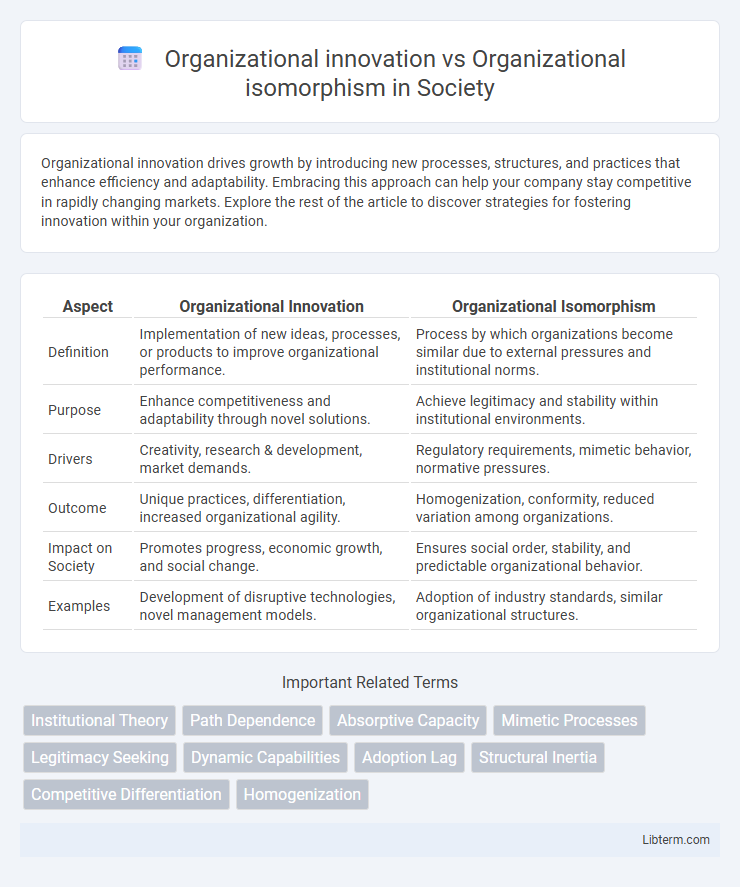Organizational innovation drives growth by introducing new processes, structures, and practices that enhance efficiency and adaptability. Embracing this approach can help your company stay competitive in rapidly changing markets. Explore the rest of the article to discover strategies for fostering innovation within your organization.
Table of Comparison
| Aspect | Organizational Innovation | Organizational Isomorphism |
|---|---|---|
| Definition | Implementation of new ideas, processes, or products to improve organizational performance. | Process by which organizations become similar due to external pressures and institutional norms. |
| Purpose | Enhance competitiveness and adaptability through novel solutions. | Achieve legitimacy and stability within institutional environments. |
| Drivers | Creativity, research & development, market demands. | Regulatory requirements, mimetic behavior, normative pressures. |
| Outcome | Unique practices, differentiation, increased organizational agility. | Homogenization, conformity, reduced variation among organizations. |
| Impact on Society | Promotes progress, economic growth, and social change. | Ensures social order, stability, and predictable organizational behavior. |
| Examples | Development of disruptive technologies, novel management models. | Adoption of industry standards, similar organizational structures. |
Introduction to Organizational Innovation and Isomorphism
Organizational innovation involves the implementation of new ideas, processes, or products to improve efficiency and adaptability within a company. Organizational isomorphism refers to the tendency of organizations in similar fields to adopt comparable structures and practices due to coercive, mimetic, or normative pressures. Understanding these concepts highlights the balance between embracing unique innovations and conforming to industry standards for competitive advantage.
Defining Organizational Innovation
Organizational innovation refers to the implementation of new ideas, processes, or structures aimed at improving efficiency, effectiveness, or competitive advantage within a company. It involves proactive change and creativity that lead to unique organizational capabilities and differentiation in the market. Unlike organizational isomorphism, which emphasizes conformity and similarity to industry norms, organizational innovation drives distinctiveness and novel value creation.
Understanding Organizational Isomorphism
Organizational isomorphism describes the process where organizations within the same field become increasingly similar due to external pressures such as regulatory requirements, market competition, and professional norms. This phenomenon contrasts with organizational innovation, which emphasizes unique changes and novel practices that differentiate a company from others in its environment. Understanding organizational isomorphism helps explain why firms often adopt similar structures and strategies to gain legitimacy and reduce uncertainty in their industries.
Key Differences Between Innovation and Isomorphism
Organizational innovation involves the introduction of new ideas, processes, or products that enhance competitive advantage and drive growth, whereas organizational isomorphism refers to the process by which organizations become similar due to external pressures such as regulations, norms, or mimetic behavior. Innovation emphasizes creativity, differentiation, and change, while isomorphism highlights conformity, standardization, and homogenization within an industry or sector. The key difference lies in innovation driving unique organizational value versus isomorphism promoting legitimacy and stability through imitation.
Drivers of Organizational Innovation
Drivers of organizational innovation include technological advancements, competitive pressure, and evolving customer demands that push firms to develop novel processes, products, or services. Unlike organizational isomorphism, where entities conform to external norms and pressures for legitimacy and stability, innovation is propelled by internal ambition and strategic intent to achieve differentiation and growth. Internal factors such as leadership vision, organizational culture, and resource availability also play critical roles in fostering an environment conducive to continuous innovation.
Mechanisms of Organizational Isomorphism
Organizational isomorphism occurs when firms within the same industry adopt similar structures or practices due to coercive, mimetic, and normative mechanisms. Coercive isomorphism arises from formal and informal pressures from regulatory bodies, mimetic isomorphism results from uncertainty-driven imitation of successful competitors, and normative isomorphism stems from professionalization and shared norms within industries. These mechanisms lead to homogeneity in organizational forms, contrasting organizational innovation that emphasizes unique, creative adaptations to achieve competitive advantage.
Impacts on Competitive Advantage
Organizational innovation drives competitive advantage by introducing unique processes, products, or business models that differentiate a firm in the marketplace, fostering adaptability and long-term growth. In contrast, organizational isomorphism leads firms to mimic competitors' strategies and structures, often resulting in homogeneity that limits distinctiveness and diminishes opportunities for competitive differentiation. Companies that prioritize innovation over isomorphic conformity are more likely to develop sustainable advantages through creative value creation and dynamic capabilities.
Balancing Innovation and Conformity in Organizations
Organizational innovation drives competitive advantage by fostering novel ideas, processes, and products, while organizational isomorphism promotes conformity through mimicking industry standards and established practices. Balancing innovation and conformity requires integrating flexible structures that encourage creativity without sacrificing coherence or legitimacy within the institutional environment. Effective management nurtures adaptive cultures that simultaneously embrace change and adhere to critical norms, ensuring sustainable growth and resilience.
Case Studies: Innovation vs Isomorphism in Practice
Case studies illustrate organizational innovation through companies like Tesla, which redefines automotive manufacturing with electric vehicles and sustainable energy solutions, showcasing disruptive innovation. Conversely, organizational isomorphism is exemplified by traditional banks adopting similar digital platforms and security protocols to align with industry norms and regulatory pressures. These cases highlight how innovation drives unique competitive advantages, whereas isomorphism ensures legitimacy and conformity within established institutional frameworks.
Future Trends and Strategic Implications
Organizational innovation drives adaptive capacity by introducing novel processes and technologies, enhancing competitive advantage in rapidly evolving markets. In contrast, organizational isomorphism leads to homogeneity as firms mimic industry leaders to gain legitimacy, which may stifle creativity and limit strategic differentiation. Future trends indicate a strategic balance is crucial, leveraging innovation to foster unique value while managing isomorphic pressures through dynamic capabilities and flexible organizational structures.
Organizational innovation Infographic

 libterm.com
libterm.com